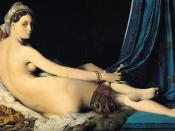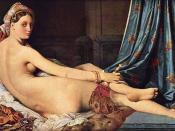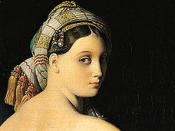This essay is comparing paintings of reclining female nudes thru the history of art. -
Ingres' "La Grande Odalisque" and Manet's "Olympia" a Comparison
The reclining female nude has been a recurring image in the history of European art. Each artist through time approaches the subject in a different, individualized way. An earlier example of the reclining nude is Giorgione's "Sleeping Venus," created around 1510(see fig. 1). His nude is painted using the clair obscur method with soft, blurred lines, making her fair skin fade slowly into the dark background. Her eyes are closed, giving an aura of innocence, because she is unaware of being observed. Also, Giorgione seems to be experimenting with background in the painting. When examining the painting as a whole, one does not simply see the reclining figure, but the diverse and unusual background also attracts the eye. The fact that the background is open is a certain indication of classical influence on this Renaissance artist.
Later, in 1796, Goya began his version of the reclining nude, "The Nude Maja"(see fig. 2). This painting was ahead of its time, in the respect that the Spanish society was not ready to view this "obscene" image. She was considered obscene because of her provocative position of frontal nudity, and because this is the first time a nude has been painted in awareness of the painter; her gaze is focused outward.
About thirty years later, in 1814, Ingres paints "La Grande Odalisque"(see fig. 3). She, like Goya's "Maja" was rejected at first by society, but for different reasons. She was not rejected because she was "obscene," but because her body was an unnatural shape; her long back does not seem proportional to her small head. One critic of Ingres said, "She has three...


